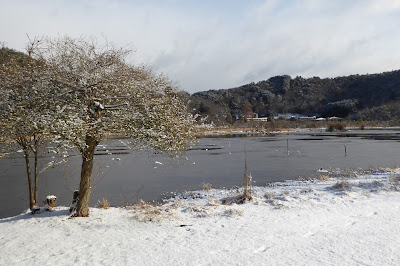If the village of Šušara is the ’appendix’ of Banat1, as my hostess Leonora puts it, then the nearby Zagajička Hill is Šušara’s blind alley2. To get to the hilltop, which dominates the famous Deliblatska Dunes, you not only need to cross several kilometers of a traecherous country road, you also need to find the correct route, because it is a road without signs, a road flanked by tall sunflowers, a road that forks in unknown directions, a road that Google Maps does not recognize. Along this dead-end lane you hit upon muddy potholes, tractor ruts, piles of rocks, which means risking either getting stuck or messing up your car. Of course, there is a third option, the most reasonable one, and that is to give up the devilry altogether, which would call for some wild manouvering into the sunflowers in order to make a u-turn. Only the insane come here in their 2WDs.
Slumped sunflower
heads – rainwater
isn’t a mirage
After a few wrong turns and countless boulders and potholes bypassed, at long last you spot the stone obelisk erected on the highest point of Zagajička Hill: what a relief! Once you’ve reached the top you soon realize getting here was very much worth all the sweat and aggro. Ah, if only all blind alleys were so pretty! The grassy hills gently undulating like the backs of giant green horses, sheep bells clanging at the bottom of the vale, to the right the honey-coloured hills, yellowed tall grass waving in the wind.
Along the dunes
sheep, green hills...
seeking in vain
a grain of sand
The winds are more or less constant. Since the Ice Age air currents carried sand from the deposits of the mighty Danube, and over the centuries vast dunes overwhelmed Banat. In the early nineteenth century under the auspicies of the Hungarian authorities the reforestation of the Deliblat dunes, a.k.a. the European Sahara, began. This forestation went hand in hand with a gradual settlement of the Banat region by various ethnic groups, including Germans, Serbs, Austrians, Slovaks, Hungarians, and lasted for a century until the beginning of the Great War, then resumed after WW2. Today, strong winds have a new role as they help spin gigantic turbines in the lowlands near Izbište village. On the Zagajička Hill a tall meteorological pole was erected some years ago in order to measure the wind speeds. Today the pole sadly hangs in defeat, having been broken by the force of gales.
Zagajička Hill is home to the largest European colony of the mole-rats (’blind doggies’ in Serbian). Up close the creature looks a ball of fur out of which two pairs of long incisors and a couple of pointed nostrils protrude. The mole-rat is an endangered species. It loves potatoes, as do the people of Banat. At dinner, Leonora wears a blue floral dress. She serves me baked potatoes, quips it feels heavenly living here in Šušara: ’It feels you’re at the edge of the world’. For a moment I indulge a thought of settling in here for good. I would, if only beds were comfortable.
Late summer, 2025
1 – Banat is a region in northeastern Serbia, mostly flatland
2 – in Serbian the appendix is called ’slepo crevo’, literally ’a blind-ended gut’

















